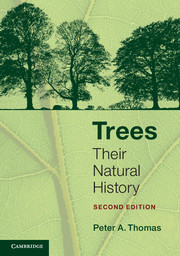Book contents
- Frontmatter
- Epigraph
- Contents
- Preface
- Chapter 1 An overview
- Chapter 2 Leaves: the food producers
- Chapter 3 The trunk and branches: more than a connecting drainpipe
- Chapter 4 Roots: the hidden tree
- Chapter 5 Towards the next generation: flowers, fruits and seeds
- Chapter 6 The growing tree
- Chapter 7 The shape of trees
- Chapter 8 The next generation: new trees from old
- Chapter 9 Age, health, damage and death: living in a hostile world
- Chapter 10 Trees and us
- Further Reading
- Index
- References
Chapter 5 - Towards the next generation: flowers, fruits and seeds
Published online by Cambridge University Press: 05 July 2014
- Frontmatter
- Epigraph
- Contents
- Preface
- Chapter 1 An overview
- Chapter 2 Leaves: the food producers
- Chapter 3 The trunk and branches: more than a connecting drainpipe
- Chapter 4 Roots: the hidden tree
- Chapter 5 Towards the next generation: flowers, fruits and seeds
- Chapter 6 The growing tree
- Chapter 7 The shape of trees
- Chapter 8 The next generation: new trees from old
- Chapter 9 Age, health, damage and death: living in a hostile world
- Chapter 10 Trees and us
- Further Reading
- Index
- References
Summary
Like other plants, trees have to engage in sex by proxy, using the wind, water or an animal as an intermediary to get pollen from one tree to another (see Box 5.1). Unlike many other plants, the sheer size of trees raises extra problems of pollination, and eventually seed dispersal, which are solved in ingenious ways. The original trees, the conifers, were (and still are) wind-pollinated. The flowering plants (angiosperms), which includes hardwood trees, evolved hand in hand with insects to be, not surprisingly, primarily insect-pollinated. Yet some have reverted to the old way of wind pollination, and for very good reasons. These are linked to geography: most trees in high latitudes are wind-pollinated, but animal pollination (insects, birds and mammals) becomes more important the closer one gets to the tropics, reaching 95% of trees around the equator. Figure 5.1 gives an overview of general flower structure.
Animal pollination
Animal pollination is primarily the world of the insect; in the wettest Costa Rican forests, for example, 90% of trees are insect pollinated. But within insect pollination there are different strategies. Some trees, like magnolias, apples, rowan (Sorbus aucuparia), European spindle (Euonymus europaea), some maples, hawthorns (Crataegus spp.) and a long list of others, go for quantity. They are generalists that spread the pollen on a wide range of flies and beetles in the hope that some will arrive on another flower of the same species. Common features are open flowers, often facing upwards, a drab colour, many stamens, easily reached nectar and a strong scent, especially at night (see Box 5.2 and Figure 5.2).
- Type
- Chapter
- Information
- TreesTheir Natural History, pp. 154 - 204Publisher: Cambridge University PressPrint publication year: 2014

